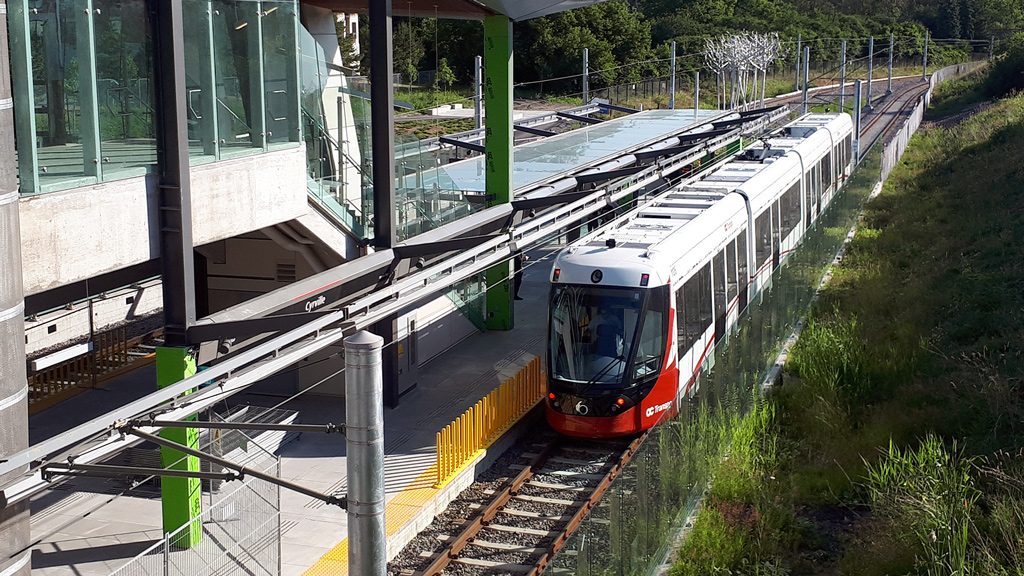The City of Ottawa will be constructing 24 new rail stations and 44 kilometres of track in the next six years. When the $4.66-billion project is complete, 77 per cent of all Ottawa residents will live within five kilometres of a train station.
With the investments in light rail transit (LRT), Ottawa will greatly improve mobility in terms of expediency, efficiency and convenience in ways that transit (buses) can’t, says the city.
“This is the story that we tell about transit in Ottawa,” says Michael Morgan, director of the Rail Construction Program with the City of Ottawa.
“In the downtown core buses are lined up back to back to back to back. The story here is about 1) resiliency — how does that system work in shared downtown traffic conditions or in winter conditions; and 2) capacity — how many buses can you put through the downtown core? Right now, through the downtown core, you can basically move 10,000 people per hour per direction with a bus coming every 20 seconds. There is nothing you can really do to expand that capacity.”
The new trains are four-module (four-section) vehicles, are 48 metres in length and hold up to 300 people.
The city is combining pairs of trains to create a 100-metre train capable of transporting up to 600 people at a time.
“By replacing a bus that holds 60 people with a train that holds 600 people, we can increase capacity from 10,000 passengers per hour per direction to 24,000 passengers per hour per direction, so an immense increase in headroom in order to move people more quickly and consistently throughout the city,” says Morgan.
Ottawa’s rail system is composed of the Confederation Line (13 train stations) and Trillium Line (five stations). Confederation runs east-west, reaching only to the west side of downtown Ottawa at Tunney’s Pasture Station and extends east 12.5 kilometres to Blair Road.
Trillium Line extends eight kilometres south from Bayview Station, located one station east of Tunney’s Pasture Station.
Confederation Line
Ottawa’s LRT Stage 2 will increase the number of stations west of Bayview by 11, the number of stations east of Bayview by five and the number of stations south of Bayview by eight.
Confederation West Line will see the greatest increase in the number of new stations and 15 kilometres of new rail. Also, several stations are touchstone points for the future expansion of the city’s Bus Rapid Transit. The extended line will connect important shopping areas, as well as Algonquin College. Construction on the Confederation West Line is slated to begin later this year and is scheduled to be completed by 2025.
Five new stations and 12.5 kilometres of rail will be constructed as part of the Confederation Line East Stage 2 construction project. Construction is set to begin in 2019 and slated to end by 2024.
In the eastern part of Ottawa, 95 per cent of citizens live within five kilometres of a train station.
The Confederation Line Stage 2 construction project posed a precarious procurement problem for the city. They had to consider whether it was fair to let Rideau Transit Group — the consortium who constructed Confederation Line Stage 1 — bid on the project. The city asked companies if they would be willing to bid on the extension in competition with Rideau Transit Group, and the answer was “no.”
“They thought that the incumbent advantage would be too great and that they wouldn’t be able to offer a competitive price,” says Morgan.
“So, one of the things we did from a procurement point of view was ask Rideau Transit Group to bow out of the East-West Confederation line. In lieu, they got extra vehicles, an expanded maintenance facility and they will take on the maintenance for the entire East-West line once it’s complete.”
For the extension of the Confederation Line, which runs east-west through downtown, the city has tasked East West Connectors, which is comprised of U.S.-based Kiewit Corp. and French firm Vinci, will extend the line to the west and east.
Trillium Line
“Separately, we ran a competition for Trillium Line extensions,” says Morgan.
“Currently, vehicle maintenance, dispatch and wayside maintenance are contracted out. The city does operations, capital, life cycle works and bridge structures, so it is a mix of who is doing what and there is no central point of contact. We are turning it into a design, build, finance, maintain, so we are handing over existing assets, the existing train, lines and station for the winning team to take responsibility for it.”
The city selected TransitNEXT, a wholly owned subsidiary of SNC-Lavalin, to extend the Trillium Line to the south, upgrade existing O-Train stations and maintain the line for the next three decades.
In total, these extensions will add 16 kilometres of track and eight new stations to the eight kilometres and five stations that the Trillium Line currently provides.
The Trillium Line extension will split at South Keys station with one leg that serves the airport.
“When you come from downtown and get off at South Keys, three minutes later, a train arrives to take you to the airport,” says Morgan.
“When you take the line from the airport to South Keys, again, three minutes later, a train arrives to take you downtown.”
The number of structures in the path of the Trillium Line means that it would cost too much to double the complete track.
“There are a large number of overpasses and bridges including an existing single track tunnel, so to double track the section would be quite expensive, so rather than increase frequency, we are going with a longer train strategy, which means that current train station platforms will need to be extended in order to accommodate the longer trains,” says Morgan.
Construction on this portion is scheduled to begin later this year and is expected to be completed by 2022.




Recent Comments